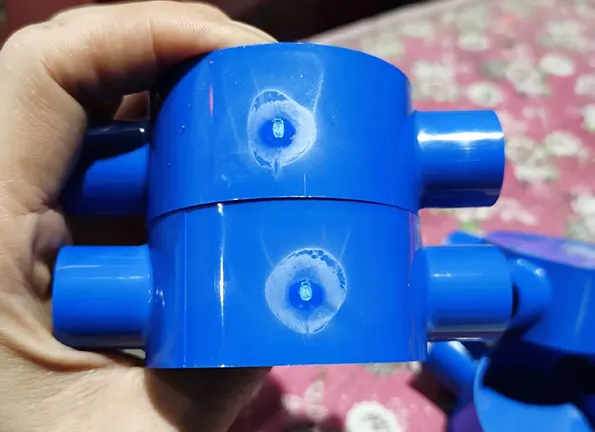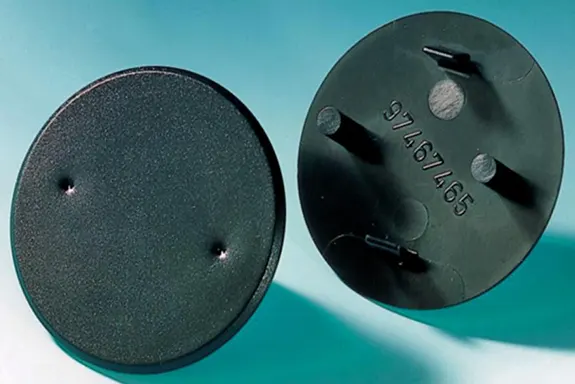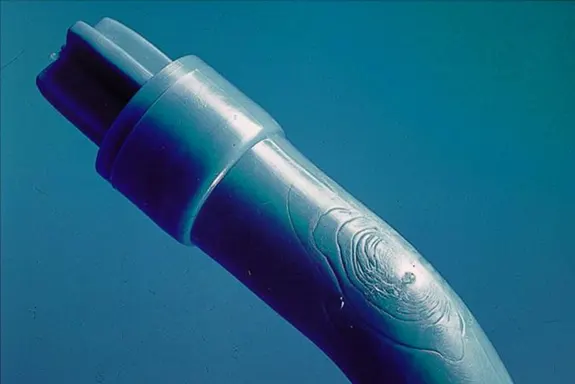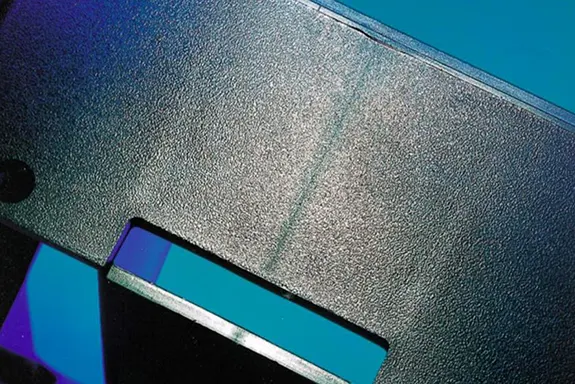Plastic parts injection molding mark defects solution ideas
Plastic injection molding is widely used to produce plastic parts in various industries.
The process involves injecting molten plastic into a mold cavity, allowing it to cool and solidify, and then discharging the finished part.
However, as with any manufacturing process, plastic injection molding has challenges.
One of the common problems manufacturers often face is the presence of trace defects in molded plastic parts.
Scarring defects in plastic parts can appear in various forms, such as warping and distortion, shrink marks, and more.
These defects affect the final product’s aesthetics and can also jeopardize its functionality and structural integrity.
Therefore, solving and preventing trace defects is crucial to ensuring the quality of injection-molded plastic parts. This paper provides an in-depth study of the trace defects encountered in plastic injection molding.
This article analyzes the root causes of these defects to provide practical solutions and insights to mitigate these problems.

Types of Plastic Part Injection Molding Trace Defects
Trace defects are imperfections or flaws in plastic parts that occur during the injection molding, usually in the form of non-smooth surfaces, visible marks, or shape distortions.
These trace defects may affect the appearance and performance of plastic parts, reducing their quality and usability. The common causes are as follows.
Warp deformation occurs
Warpage deformation is a common type of trace defect that usually occurs during the injection molding process.
The main characteristic of this defect is that part or all of the plastic part presents an abnormal curved or bent shape instead of a straight or flat shape that meets the design requirements.
Warp deformation may result in a plastic part that does not fit or work properly.
In automotive parts manufacturing, a plastic dashboard assembly must be manufactured by injection molding.
However, a warpage deformation problem occurred during the manufacturing process.
After analysis, it was found that this was due to uneven mold temperature control.
Some areas of the mold were too hot while others were too cold, resulting in premature plastic hardening in some regions after injection molding, which triggered warpage deformation.
Injection molded parts are prone to shrink marks
Shrink marks on injection molded parts are a common defect of injection molding marks, which usually appear as depressions or pits on the surface or inside of the plastic parts.
This problem can result from various factors, including improper injection parameters, inappropriate material selection, and poor mold design.
One common scenario is that when injection pressure is insufficient or injection speed is too fast, the plastic fails to adequately fill small structures or complex areas in the mold, resulting in shrink marks.
This is especially common with plastic parts that have a fine bumpy texture.
In addition, if the selected plastic material does not have sufficient fluidity during the injection molding process, this can also lead to shrink marks.

Poor surface replication
Poor surface replication refers to the appearance of abnormal patterns, defects, or subtle textures on the surface of the injection-molded product, usually due to the mold’s uneven or damaged surface.
Such imperfections can significantly affect the appearance and quality of the product, especially in applications requiring high precision and smooth surfaces.
Various factors, including mold quality, material selection, the injection molding process, and environmental conditions often influence this problem.
One common cause is poor mold surface quality, such as rough, scratched, or worn surfaces. These can lead to poor surface reproduction problems as the mold fails to replicate details and textures onto the injection-molded product properly.
In addition, the longevity and maintenance of the mold can significantly impact surface reproduction, and damaged or worn mold surfaces will lead to quality degradation.
Another cause is poor material selection.
Certain plastics may not easily bond completely to the mold surface during the injection molding process, resulting in poor surface quality.
In addition, the setting of injection process parameters may also affect the surface quality. For example, too high injection speed, temperature or pressure may lead to poor mold surface reproduction.
Tiger skin quality defects
Tiger Skin is a common injection molding product quality defect, which is usually manifested by the appearance of stripes or textures on the product’s surface that resemble a tiger’s skin.
This phenomenon may reduce the appearance quality of the product and make it lose its smooth and uniform appearance.
During the injection molding process, the uneven distribution of the mold temperature may cause certain areas of the product surface to cool too quickly while other areas cool more slowly, and this uneven temperature can lead to the appearance of tiger-skin-like textures on the product surface.
Second, the design and structure of the mold may cause tiger skin texture.
Suppose the mold’s design is unreasonable, for example. If the cooling system on the surface of the mold is not properly laid out, insufficient cooling will occur in some areas, leading to tiger skin texture quality defects.
Suppose an injection-molded product is required to have a smooth appearance, but the uneven temperature distribution in the mold results in a tiger stripe on the product’s surface.
This is because certain areas are cooled too quickly while others are cooled more slowly, resulting in a textured product surface.
This can significantly affect the appearance and quality of the product.

Fusion Mark Defects
Fusion marks are a common quality problem in injection-molded products. They are usually formed when the molten plastic splits into two pre-flow parts during the flow process and then meets again due to the cooling of the pre-flow part of the resin, making it difficult to fuse fully.
There are various reasons for producing fusion marks, mainly including:
One is the poor fluidity of the plastic, resulting in a slow injection speed, and the different parts of the plastic can not be fully fused.
Second, the structure of the plastic product will affect the flow of resin, such as too many holes, complex geometry, etc. will increase the probability of fusion marks;
Third, the mold design is unreasonable, including unscientific gate design, the mold temperature is too low, and other factors will affect the quality of fusion welding;
Finally, foreign matter such as mold release agents and volatiles caught in the plastic’s sink will also affect the formation of the sink and weld.
The appearance of fusion mark defects will not only affect the aesthetic appearance of injection-molded products but also reduce their impact strength.
Therefore, effective measures need to be taken to solve this problem and reduce fusion mark defects.

Burr
Burr is a common plastic injection molding mark defects, which is manifested in the surface of the injection molded products appear small and sharp protrusions, usually adversely affect the appearance and quality of the product.
The causes of burrs are varied and usually involve the following aspects.
First of all, unreasonable mold design is one of the leading causes of burr problems.
Improperly designed discharge ports in the mold, defects in the injection system, or high surface roughness of the mold can all lead to burrs.
Secondly, improper setting of injection parameters can also cause burrs. Too fast injection speed and too high injection pressure will make the plastic flow too rapidly and increase the risk of burrs.
Further, the selection and handling of plastic raw materials can also affect the generation of burrs.
Plastic materials with a low melt index or excessive impurities are more likely to lead to burr problems, as are mold aging and wear.
Unevenness or scratches on the surface of the mold will affect product quality and increase the chance of burrs.
Cracking
Burr is a common plastic injection molding mark defect, which is manifested as small and sharp protrusions on the surface of injection molded products, usually adversely affecting the appearance and quality of the product.
The causes of burrs are varied and usually involve the following aspects.
First of all, unreasonable mold design is one of the leading causes of burr problems.
Improperly designed discharge ports in the mold, defects in the injection system, or high surface roughness of the mold can all lead to burrs.
Secondly, improper setting of injection parameters can also cause burrs.
Too fast injection speed and too high injection pressure can make the plastic flow too quickly, increasing the risk of burrs.
Further, the selection and handling of plastic raw materials can also affect burr generation.
Plastic materials with a low melt index or too many impurities are more likely to cause burr problems.
Aging and wear of the mold can also lead to burrs.
Unevenness or scratches on the surface of the mold can affect product quality and increase the chance of burrs.
Plastic parts injection molding mark defects solution ideas
Eliminate warping and deformation defects
Using the above structural design, it is necessary to effectively improve the strength of injection-molded parts to eliminate the self-plastic buckling deformation in typical defects.
Optimization of the mold structure is a critical step. At the mold design stage, reinforcements can be considered to increase the overall strength of the injection molded part.
This involves adding a suitable number and location of reinforcement structures in the mold to mitigate the occurrence of self-plastic buckling deformation.
A reasonable mold structure design can ensure uniform distribution of plastic materials and reduce stress concentration, thus effectively reducing the risk of warpage deformation.
In addition, selecting higher-strength and rigidity plastic materials can effectively mitigate self-plasticized buckling deformation.
These materials are more likely to maintain shape stability after injection molding, thus reducing the possibility of warpage deformation.
In addition, wall thickness uniformity control is one of the key factors in preventing warpage deformation.
By accurately controlling injection process parameters such as temperature, pressure and cooling time, it is possible to ensure that the plastic cools uniformly during the injection process, thus reducing the risk of warpage deformation.
Self-plastic buckling deformations due to thermal stresses can be avoided by ensuring uniform mold temperatures.
This can be achieved by using a thermostatic system and an appropriate cooling system to ensure mold temperature stability.
Preventing the occurrence of shrink marks
Preventing the shrink marks problem is a key challenge, especially in the design of automotive plastic parts.
In some cases, such as automotive plastic screw posts, root indentation problems can adversely affect product performance and reliability.
To address this problem, measures need to be taken at the design stage to minimize the occurrence of shrink marks.
One common approach is to add a dimple structure to the root of the screw post.
The central idea behind this design decision is to reduce the equivalent thickness at the root of the screw post.
Typically, plastic products are prone to shrink marks when the equivalent thickness is small.
Adding a dimple to the root can effectively reduce the equivalent thickness, thereby minimizing the likelihood of shrink marks.
In addition, the properties and strength of the plastic material need to be considered at the design stage.
Different plastic materials have different modulus of elasticity, and plastics with low modulus of elasticity are prone to plastic shrink marks.
Therefore, choosing suitable plastic materials with sufficient strength can reduce the risk of shrink marks problems.
Avoiding poor surface quality
Some key measures need to be taken during the specific design and production of injection-molded parts to avoid poor surface defects on plastics, especially recurring problems.
One of these is to avoid the use of delicate skin structures.
Fine skin structures lead to poor surface quality problems when injection molding plastic. These problems are usually related to the pressure distribution in the cavity.
If the pressure distribution within the cavity is not uniform, it may lead to surface imperfections or uneven textures.
Therefore, to minimize potential problems, it is necessary to avoid using overly fine or complex skin texture structures in the design of specific automotive plastic injection-molded parts.
In addition, during the production process, it is necessary to ensure that the melt has sufficient pressure to replicate the mold surface.
This can be achieved by using high pressures, high speeds, and high temperatures to ensure that the melt effectively fills the cavity and replicates the mold surface.
These conditions can help minimize the loss of melt pressure and thus improve the consistency of surface quality.
Reducing tiger stripe conditions
Mold design can have a positive impact on reducing tiger stripes. Smooth mold surfaces and proper cooling systems can reduce the occurrence of tiger stripes.
The surface quality and smoothness of the mold plays a key role in the appearance quality of the final product, so you need to ensure that the mold surface is polished and flat.
In addition, controlling the injection speed, temperature and pressure can improve the flow of the melt and reduce the appearance of surface texture.
Optimization of injection parameters requires experience and experimentation to achieve the best results.
For some specific products, post-treatment processes such as painting or surface treatment can be used to minimize the visibility of the tiger skin pattern.
This can improve the product’s appearance to a certain extent, but it still requires the previously mentioned control measures during the manufacturing process to minimize the occurrence of tiger stripes.
Reducing splice mark defects
To reduce splice mark defects, manufacturers must consider a combination of material selection, mold design and injection parameters.
Fusion weld marks are usually found in plastic products. These marks appear as short linear depressions, reducing the quality of the product’s appearance.
Fusion marks can be minimized by selecting plastic materials with higher fluidity and lower shrinkage.
For example, using materials such as polypropylene (PP), which has better flow properties, can help minimize fusion marks. Second, mold design must consider reducing the formation of fusion splice marks.
When designing a mold, avoid sharp corners or too many holes, which can help reduce the appearance of weld marks.
For example, manufacturers of automotive interior parts usually avoid using too many sharp corner structures in their mold design to reduce the visibility of fusion weld marks on the product surface.
In addition, controlling injection parameters is also a key factor in minimizing weld marks.
Controlling the injection speed and temperature improves the flow of the melt and reduces the formation of weld marks.
For example, in the manufacturing process of electronic product shells, precisely controlling the injection speed and temperature can reduce the appearance of fusion marks and improve the shell’s appearance quality.
Elimination of burr defects
Elimination of burr defects is about how to deal with the undesirable phenomena produced during the injection molding manufacturing process, i.e., the appearance of small or tiny sharp protrusions on the surface of the product.
These burrs hurt the appearance and performance of the product and therefore require appropriate measures to be taken to address.
One effective way to reduce burr generation is through improved mold design.
This includes avoiding sharp edges and reducing dead space in the mold to minimize the intersection of plastics during the filling process.
For example, in automotive parts manufacturing, some injection molds incorporate rounded corners or chamfers at the design stage to avoid burrs, thereby improving the appearance of the product.
Another key factor is controlling injection molding parameters, including temperature, pressure and speed.
By optimizing these parameters, melt flow can be improved and burr formation can be reduced.
For example, in medical device manufacturing, burrs on the product surface can be effectively reduced by precisely controlling the injection molding parameters to ensure product safety and hygiene standards.
In addition, material selection is also the key to solving burr defects.
Selecting plastic materials with higher fluidity and lower viscosity can reduce the occurrence of burrs.
For example, manufacturers of electronic product housings often choose high-performance plastics such as polycarbonate (PC) to ensure that the product has a smooth appearance and no visible burrs.
Eliminate Cracking Defects
Cracking defects are a common headache problem in injection molding.
Cracking not only affects the product’s appearance but may also reduce its performance and life.
The following related measures can be taken to reduce or eliminate cracking defects.
1) Material selection:
Selection of suitable plastic materials is very critical to minimize cracking.
Different plastics have different physical properties, melting points, and heat distortion temperatures, which will affect the product’s heat and cold resistance.
Choosing materials with better cold resistance, such as ABS or PC, can reduce the risk of cracking.
2) Mold design:
Proper mold design can also reduce the possibility of cracking.
Avoid sharp internal corners, excessive wall thickness differences and excessive surface texture, which can lead to stress concentrations and increase the risk of cracking.
In addition, a proper cooling system can prevent localized overheating and reduce cracking.
3) Control of injection molding parameters:
Parameters in the injection molding process, such as injection speed, injection pressure, mold temperature, etc., need to be precisely controlled.
Too high or too low injection speed and pressure may lead to cracking.
Suitable adjustment of mold temperature can also reduce thermal stress and cracking.
4) Recycling and reuse of residual materials:
Proper recycling and reuse of residual materials can reduce waste, but it is necessary to ensure that the recycled plastic material is evenly mixed, otherwise it may lead to uneven shrinkage and increase the risk of cracking.
5) Nozzle and mold maintenance:
It is important to regularly inspect and maintain the nozzles and molds of your injection machine.
Damaged or worn nozzles can lead to uneven injection, while damaged molds are also prone to cracking problems.
Conclusion
Trace defects are a common problem in the injection molding of plastic parts. They may affect the appearance and performance of the product and reduce quality.
This paper examines different types of trace defects, including warpage deformation, shrink marks, poor surface replication, tiger stripes, fusion marks, burrs, and cracking.
By analyzing the causes and solution ideas for each type of defect, we can better understand how to reduce or eliminate them.
Optimization of mold design, rational material selection, control of injection parameters, and maintenance of equipment and molds are all key factors in reducing trace defects.
Also, avoiding excessive structural complexity and rough surface textures can help reduce defects.
Manufacturers must work closely together during the design and production process to ensure optimum results. Only by considering all factors can high-quality injection-molded products be produced.